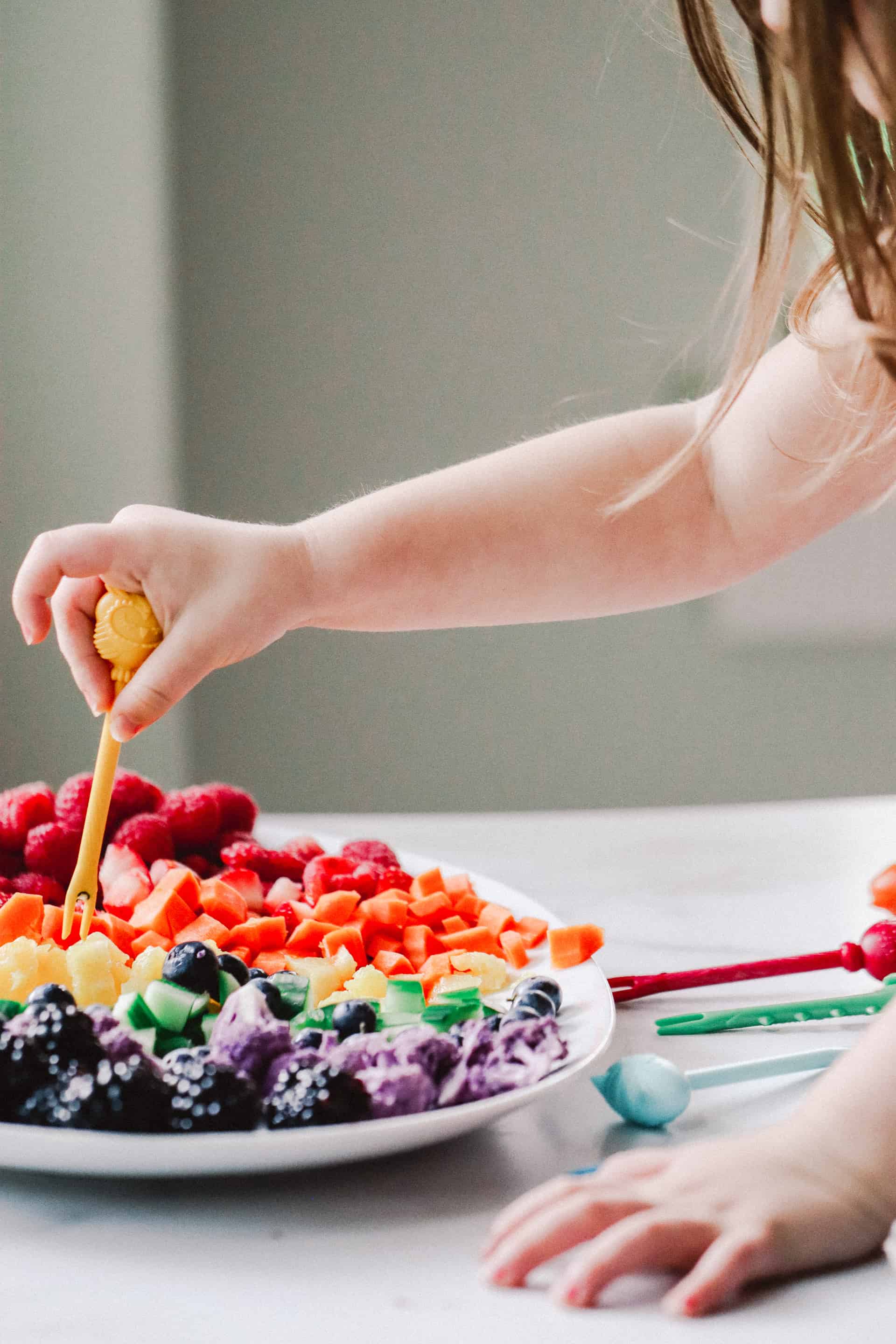
Menu
As a parent, you’re responsible for so many things. It starts logistical: keep them safe, dry, fed, and loved. But then, it becomes next-level: shape the way they view the world and the people they’ll become. (No pressure, right?)

Whether it came from within our homes or outside, a lot of us were raised with diets, diet culture, and a big focus on our appearance. And we might be changing our views on these topics now (painstakingly….and with so much effort and intention…and maybe even therapy). But unfortunately, our kids are still not exempt from the messaging that taught us all the wrong things back when we were young.
I will never forget when I was entering seventh grade, I got a horrible virus over the summer time. I was sick for weeks, and couldn’t eat much. When I was finally feeling well enough to get back to my soccer team, a friend’s mom commented on my weight loss and how she wished she had gotten my sickness. I remember thinking, what an AWFUL thing to say to me. I was thrilled to be feeling better and the way my body looked was the farthest thing from my mind. But that moment taught me how much some women desired thinness.
So how do we protect them? How do we teach our kids about food and nutrition in a neutral way? How do we talk to them about food and diet culture? It’s a big topic, for sure, but this post will help you get the conversation started. And steer it in the direction that’s aligned with your values.
Diet culture represents the idea and the message that we should always be on a diet—and a pretty drastic, restrictive, limited one at that. It says we should always be restricting, trying to change the way we look, and working hard to conform to the current beauty standards.
A lot of us were raised in this culture and messaging. So much so that for many of us, it took years and a lot of convincing to even realize that it’s harmful. But once you see the ways that diet culture has informed our culture at large—and the ways it may have harmed you, your relationship with yourself, and your relationship with food personally—it’s hard to unsee. If you haven’t yet, you’ll start to notice it everywhere.
The obvious offenders are the 1990s-style magazines celebrating bodies that we now know were achieved via extreme or disordered eating. Or the checkout line magazines of today with wild claims about losing X amount of pounds in a matter of hours.
But diet culture shows up in somewhat more subtle ways, too. Like the “guilt-free” food labels that suggest that we SHOULD have guilt for eating other, similar products. Or the low-calorie weight loss plans, marketed as being a way to achieve better health. It can even come from loved ones who aren’t necessarily to blame (they grew up in this culture, too). They may say things like, “Wow, I could never eat that much!” or “No dessert for me, sugar is a killer!”

Kids are not exempt from the messaging of diet culture. Chances are, your kids will hear about good foods vs. bad foods at school or from friends. They will be exposed to diets and weight loss from an ad at some point. Or a chronic-dieter grandma will make some comment when you’re not around.
And it’s not like our kids just hear these things and move on with their lives, either. Sadly, multiple studies have found that kids are engaging in dieting behaviors and demonstrating body dissatisfaction at extremely young ages.
The non-profit Common Sense Media did an in-depth review of much of the existing research on diet culture and kids and found that “1 in 4 children has engaged in some type of dieting behavior by age 7” and that “80% of 10-year-old American girls have been on a diet.”
They also found that these dieting behaviors were linked with negative body image. “More than half of girls and approximately one-third of boys age 6 to 8 indicate their ideal bodies are thinner than their current bodies,” they wrote.
During early childhood, kids internalize the message that there is something wrong with their bodies, then actually start trying to change them. That is horrifying.
So even though it might seem like the most neutral way to go about things, simply not talking to our kids about food and nutrition isn’t the best option. We have to intentionally, clearly, and outwardly teach them. Having the right type of conversations at home matters!

If you were raised with a huge influence from diet culture or you’re struggling with your relationship to food and your body right now, these conversations might feel hard. You might feel like you’re faking it. And that’s okay.
There is a correlation between a parent’s relationship with food and their body and their children’s relationship with food and their body. I don’t say this to scare you. I mean, it’s clear that we have a huge responsibility here. But, we also have an opportunity to break the cycle of diet culture. We can raise kids who are confident enough in themselves to resist and maybe even change the cultural messaging.
If you’re struggling with food right now, take heart. Because A) you’re not alone in that struggle AT ALL. And B) no matter how much diet culture may have informed the way you were raised, you CAN pass something different on to your kids.
It’s not easy. It requires going against the grain of a nasty part of our culture that is so pervasive and choosing to talk about food and our bodies DIFFERENTLY with our kids. (Even when that feels totally unnatural to us!) But it is such worthwhile work. And I bet it will help you change the way you feel about food and your body in the process, too.
Being a parent is such important work. We won’t do this perfectly (I don’t do anything perfectly), but if we try, we can change the narrative for the next generation. And help them celebrate their bodies and pursue health that looks different from what the magazine covers might suggest. So let’s get into it!

I know this can sound like a kid-friendly way to frame food because it’s so simple. But I would avoid saying “good food vs. bad food” for exactly that reason: it’s overly simple. And because it comes with a morality judgment—kids learn to think that since foods are good or bad, THEY are either good or bad based on what they eat. This can lead to a lot of food perfectionism, especially if they are motivated to please others.
The truth (from a Registered Dietitian who studied nutrition and has worked in this field for YEARS, let me remind you!) is that food is NOT just good or bad. It can’t be broken down into black and white. And it definitely doesn’t have moral value. What you eat doesn’t have any bearing on whether you are being good or being bad.
All food is some combination of macronutrients. Those macronutrients are found in different quantities and preparations, and with different characteristics in different foods, absolutely. But none of that has any moral significance. It’s neutral.
Am I saying all food is the same and we shouldn’t look any deeper into it and we should eat ice cream for breakfast, lunch, and dinner because it’s delicious and tell our kids to do the same? No.
I know that it would be SO NICE to have a straight-shot answer or a hack for this. (For anything in parenting, really.) But as with most important things, extremes are never the answer. This is all about nuance and getting comfortable talking about the details instead of just calling something “good” or “bad” and slamming the book shut.
There IS a way we can talk about foods and the different things they do in our bodies without vilifying certain foods and elevating others in the process, which we will touch on in the next section of this post.
It helps to just speak factually about food and not use words that imply that certain foods are better or worse than others. So steer clear of using words like “junk food”, “unhealthy,” “bad for you” and even “better for you.”
Because low-calorie isn’t BETTER, it’s just lower in calories. There are tons of instances where a higher-calorie option would be the better choice.
And brown rice isn’t BETTER than white rice, it just has more fiber. Which could be better for your toddler sometimes (like when they’re constipated) but worse for them on other days (like when they have diarrhea).
The point is that there is no absolute gold standard or best metric by which we should make decisions about food. And when we think there IS a gold standard, or we say there is, then we subconsciously start making choices from that place—trying to choose what’s “best” instead of what we like, want, or have access to. (And teaching our kids to do the same.)
And that can be a slippery slope toward disordered eating, or experiencing stress and anxiety over making the *best* food choices possible. We don’t want that. Because it’s true that ALL foods can fit in a healthy diet.
So what CAN we say? I promise, there ARE lots of helpful ways to talk about food in an age-appropriate way. And they’re pretty easy to wrap your head around, too, so you won’t always be editing yourself in your head before speaking. (That’s exhausting!)
If I had to sum it up, I think the best way to talk about nutrition with kids is to say that “some foods do more things in our bodies and some foods do fewer things in our bodies, but it’s great to enjoy ALL foods!”

Here are some other ways I like to teach kids about nutrition:
There are age-appropriate ways to share nutrition information. For example, a 2-year-old doesn’t care that carrots and bell peppers contain the phytochemical beta carotene which is a precursor to vitamin A that is a great antioxidant, is thought to be protective against cancer, and helps support healthy eyesight…But they might be able to latch onto the idea that orange foods help us see. And on the flip side, a 12-year-old might think all that information is super cool!
Talking about the different colors food comes in provides a visual that helps kids understand that different foods have different “jobs” in our bodies—and that our bodies need all of them.

For food items that you might know don’t have a TON of nutritional value, it’s always safe to say that those foods give us ENERGY. (Because ALL foods give us energy, that’s what calories are!) You can also say that some give us more or less energy, or that there are different types of energy, like how sugar gives you a burst of quick energy.
It’s a good idea to emphasize VARIETY and add things INTO a diet instead of restricting or taking things out. Have a brownie AND have some apple slices—it doesn’t have to be either/or.
When it comes to foods that we, as adults, know wouldn’t feel good to eat all the time, we can say just that.
I tend to call sugary foods “firecracker foods” with my kids, because they remind me of firecrackers! Firecrackers are exciting, fun, and happen quickly. Firecracker foods taste great, they give you a burst of energy, but they don’t stick with you for long. So we have to balance those firecracker foods with fuel up foods.
Another type of language that may help you is thinking of sometimes foods.
“Ice cream is SO delicious, isn’t it? I love it, too! Ice cream is one of the foods that only does a few things in our bodies, so it’s one that we eat sometimes—not all the time. We want to make sure we have space in our bodies to get all the types of foods we need!”
So you’re not micromanaging their portions, but you are instilling the idea that we wouldn’t feel great if we ate ice cream alllllll the time.
When your kids ask for something you aren’t offering (like 5 servings of dessert, for example), it’s okay to say no and hold the boundary—but try to do so without casting shame on them for wanting more or suggesting that the food they want is bad. I like to stick to something neutral like,
“That’s all the cookies on the menu tonight, we’ll have more later this week!”
(By the way, I know you wouldn’t shame your kids like this on purpose—but it’s one of those sneaky diet-culture things that we sometimes do inadvertently! So don’t beat yourself up if you’ve done it before and know that I’m not beating you up for it, either.)
This is one of the hardest parts, but kids learn the most about nutrition from us. If they see us say no to the more indulgent foods every time…or say things like “I can’t eat that!” or “I was so bad last weekend!”…or equate how much we exercise with how much we eat…or try the latest fad diet…they will internalize all that messaging.
If you scrolled down to this part of the post, scroll back up and read about how our relationships with food affect them. It’ll help if you struggle with this part!
Tell your child why you like to move your body or ask them why they do. Maybe you talk about how it’s fun to celebrate what your body can do, or that moving it’s good for your muscles, bones, and organs. The point is that movement doesn’t exist as a way to punish ourselves for what we eat, balance out what we eat, or “earn” something we want to eat later.
Modeling works great here too. When you find movement that you love and enjoy, your kids pick up on that!
Related: Teaching Intuitive Eating to Kids

I know this is a heavy topic and it’s probably a lot to think about, but you’re already doing great just by reading this. Don’t worry too much about getting all the language “perfect,” okay? I promise you’re not going to mess them up if you’ve called something junk food before or you do it again.
Give yourself grace and focus on the big picture—offering variety, enjoying all foods, and not labeling foods as good or bad. Those basic principles coupled with a general celebration of our bodies and how amazing they are is going to set your kids up to have a positive relationship with food and their bodies. And that’s what matters most!


I’m a mom of two and a Registered Dietitian Nutritionist. I offer e-guides and e-books (go to my Shop page), workshops, brand partnerships, and nutrition counseling. Check out my blog for nutrition and feeding tips for your little ones.
This post may contain affiliate links. I may earn a commission. As an Amazon Associate I earn from qualifying purchases.
0 Comments